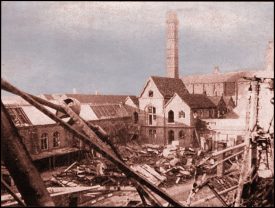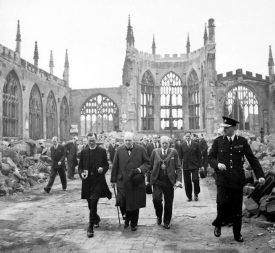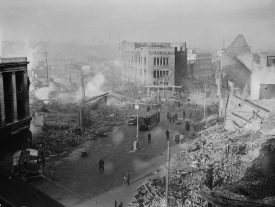The Coventry Blitz was a series of bombing raids that took place on Coventry during World War Two. By far the most devastating of these attacks occurred on the evening of 14 November 1940. It was the single most concentrated attack on a British city in the Second World War. The aim was to knock out Coventry as a major centre for war production.
“The brightest moon”
One eye witness of the time, writing to his parents shortly after the raid, had a clear view of the Luftwaffe’s attack as they lived on Gibbet Hill Road, Coventry. 14 November was a brilliant moonlit night. Our witness writes that “the moon had just got up a bit and had got nicely brilliant – as the evening worn on it became the brightest moon I have ever seen.”
Our eye witness, Marcus Sadler, in his letter to his father, Wilson Dawson Sadler in Sutton Coldfield, continues: “In the first quarter of an hour we had counted thirty two planes over, and these followed through until 5.45 am without ever one minute going past without at least one coming in. It sounded just like your bees do when they swarm.”
“Like red daylight”
Codenamed ‘Moonlight Sonata’, the raid lasted for 11 hours and involved nearly 500 Luftwaffe bombers. The Luftwaffe dropped 500 tons of high explosive, 30,000 incendiaries and 50 landmines.
Much of this could clearly be seen by Marcus: “After the first ten minutes or so the fires got going, – the second HE [high explosive] dropped had hit the main water supply, and they couldn’t get hardly any water to fight the flames – the fires extended over an oblong of about 3 x 2 miles solid flames with a nice order of smaller fires all dotted around The glow from the fire lit up the whole place as far back as Kenilworth like a red daylight.”
“White lines through the sky”
More than 43,000 homes, just over half the city’s housing stock, were damaged or destroyed in the raid. The fire at the city’s huge Daimler works was one of the biggest of the war in Britain.
Marcus continues: “[the noise and spectacle of] the anti-aircraft fires was terrific, with the tracer shells from the smaller guns cutting queer white lines through the sky, and the Bofors guns were shooting up flares, and wire mesh traps to try and catch the diving planes. Machine guns on the ground were shooting at other flares from the planes and also potting at big 2 ton land mines floating down slowly by 30 ft span parachutes.”
“Like some fantastic orchestra”
Coventry lost not only its great mediaeval church of St Michael’s but its central library and market hall, hundreds of shops and public buildings.
Marcus saw that: “Shrapnel was landing on all sides, and the whistle and whine of the shells combined with the Screamers and Whistlers seemed like violins and saxophones in some phantastic [sic] orchestra the main theme of which was the big bass crumping of the bombs, and the rolling deep throated drums of the guns.”
It is no wonder that the smell and heat of the burning city was said to have reached into the cockpits of the German bombers, 6,000 feet above.
Gibbet Hill anti aircraft guns
Marcus goes on to explain that, even in the midst of such terrifying conditions, “after a time we were even able to sleep through the last hour of it.”
A copy of Marcus’ letter was sent to us by a member of his family, who wishes to remain anonymous. They had also heard that anti-aircraft guns were kept behind Gibbet Hill Road during the war although there are no visible remains of these now. Does anyone know anything about these?










Comments
I had the opportunity to talk to my wife’s 90 year old Auntie about the Biltz and she told this story. “I was a young girl working as an office girl in the Sunbeam car company, The air raid sirens started to howl and we were instructed to get to the shelter in the building across from us. I was finishing a job and I hesitated until I was shouted at to get moving. As I ran across the street a plane came bearing down strafing the street. I thought to myself, Im not going to die being shot in the back running away. I turned and with my hands on my hips I stared down the young pilot right in the eyes. He must have let up because because I was not hit and I then continued running to the shelter.” To those who knew strong willed, Audrey Naylor this story is totally believable.
Add a comment about this page